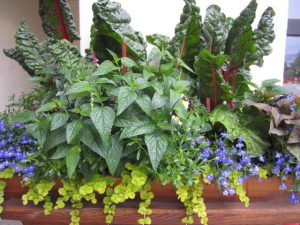Swiss Chard in Containers
Views: 10731

Using Swiss chard in a container never occurred to me until I saw it in this creative container planting outside of the fire station in Vail, Colorado. I love using plants with interesting foliage in mixed containers. Then, I don’t have to rely on flowers to carry the show.
Annual flowers often go through phases during the growing season where they may not have very many blooms. (Especially if “someone” forgets to water for a few days…). However, plants with interesting foliage will fill in those gaps and keep containers looking good, even when blooms are sparse.
For example, in the picture, even though the blue Lobelia is the only plant flowering in the combination, it is still an attractive planter. (Other plants pictured include Golden Creeping Jenny (my favorite ‘spiller’ plant). Salvia (my best guess is ‘Mystic Spires’ Blue Sage). There’s a purple Sweet Potato vine tucked into the planter on the far right.)
Beautiful, edible Swiss chard
Swiss chard, or Beta vulgaris, adds a nice vertical element to a mixed container. It contributes both interesting texture and color. Best of all, you can eat it too! Depending on the variety, chard matures between one and three feet tall, so it is best used at the back of a mixed container planting, or as a central vertical element. The stiff vertical stalks of chard are the star of the show. They come in white, red, orange, purple, yellow, or pink. Most varieties offer one of these stalk colors with a green leaf, but the ‘Bright Lights’ and ‘Rainbow’ series of Swiss chard produce stems in multiple colors. Chard grows best in full sun to part shade (preferably in the afternoon). It’s not too fussy about soil conditions or consistent moisture. (Of course it will perform better if watered consistently, but it can handle occasional neglect).
Growing
Swiss chard is easy to grow from seed. It can either be sown directly in outdoor containers in mid to late spring, or, for a head start, can be started indoors in early spring. Even though chard can handle light frosts, it’s better to wait until your average last frost date to plant young plants outdoors. Both the leaves and stems of Swiss chard are edible. They are chock full of vitamins K, A, and C, plus a healthy dose of magnesium, potassium, and iron.
Harvest some for dinner by cutting stems near the base when they are between nine and twelve inches tall. The plant will keep producing new stems throughout the growing season. The whole plant can be harvested as long as the center growth point isn’t damaged, but this method is better used in vegetable gardens rather than mixed containers, since it will leave a gaping hole in your planting.
Chard is a versatile leafy vegetable and can be prepared in many different ways. A quick internet search will produce hundreds of recipes ranging from a simple quick sauté with garlic and lemon, to soups, creams, and stuffings. Basically, chard can be used in pretty much any recipe calling for a green leafy vegetable (e.g. as a substitute for spinach), but I especially love it in a quiche. Well, to be honest, I love anything in a quiche…
Meet Abbi Hayes
Abbi's Recent Posts

Kalanchoe delagoensis: Mother of Millions







